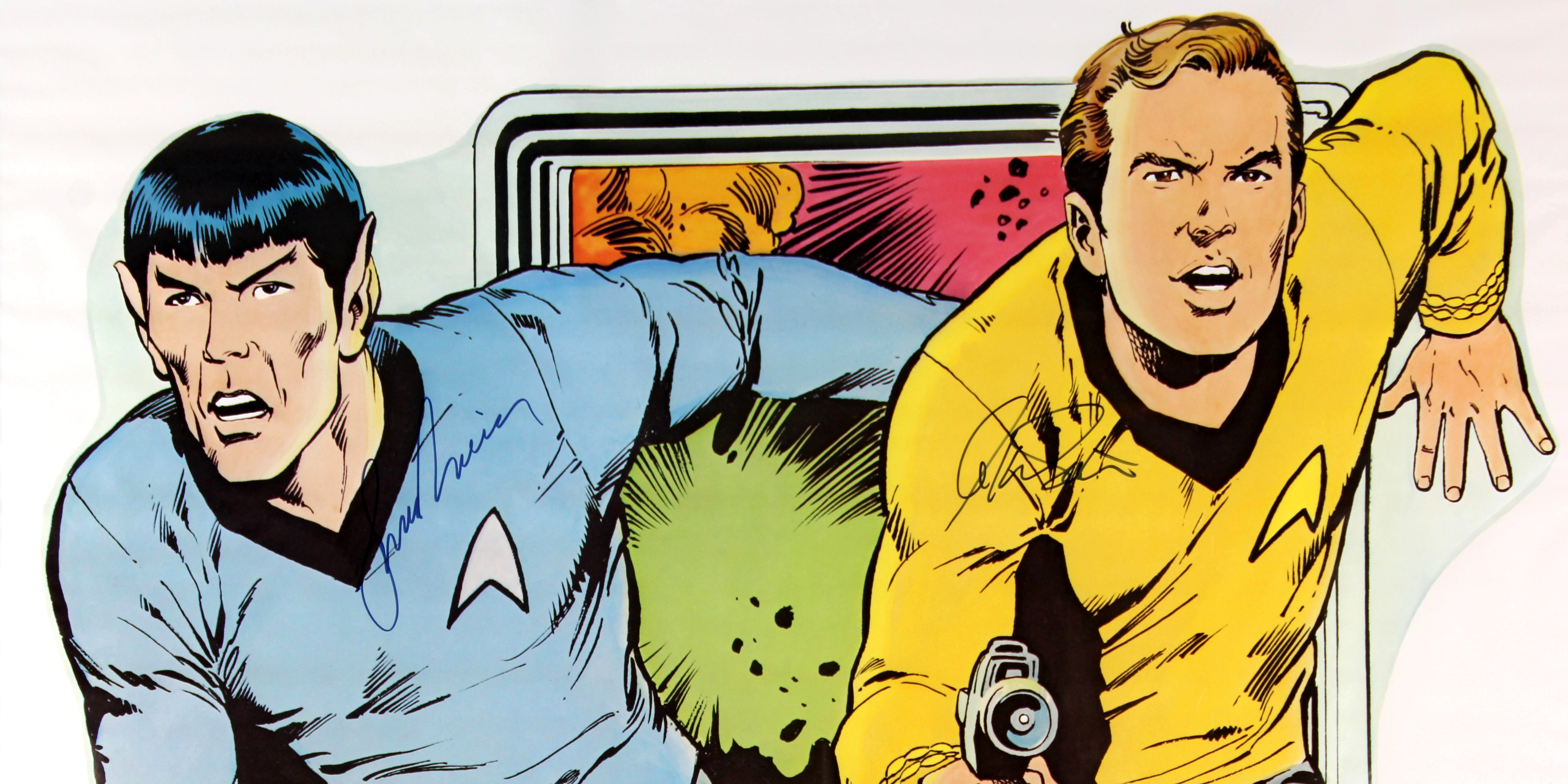The serial number of the USS Reliant is NCC-1864. I’ve known that since 1984, when my family got a VCR and I could pause a rented copy of The Wrath of Khan. Pausing let me study details, and that was a game changer. Soon I was recording TOS repeats and taking 90 minutes to play and pause my way through the episodes.
I had a similar experience years earlier in 1979, when I discovered the Star Trek Fotonovels. These were essentially graphic novels that used episode images instead of drawings. Created by Mandala Productions and published by Bantam Books, 12 were released between 1977 and 1979, with one episode per book. I bought my first one at Bakka in Toronto, and grabbing one whenever I had a few dollars is one of my favourite collecting experiences.
You could linger on an image, examine the bridge and see the relative positions of the crew, look at the buttons on the consoles, note that a crewmember had a tricorder slung on one shoulder. The books were better for images than dialogue, however. The first issue in the series was, inevitably, The City on the Edge of Forever, and this pic from the opening puts words in our captain’s mouth that he never said on screen.


And it’s true that the images weren’t always stellar. This one, for example, is not kind to Scotty.
Most others, though, are great, and fans like me would often have these books fall apart from hours of use.


“Encounter with an Ellison“
A nice feature of these books was the supplemental material. Issue #1 has a good, albeit sadly brief, interview with Harlan Ellison, who wrote the screenplay on which the episode is based. The interview, conducted by Sandra Cawson (about whom I could find no information), opens with a description of Ellison’s home:
Harlan Ellison’s home is a calculated fall down a rabbit hole. Every wall scintillating with original paintings by the Italian Campanile, the German Wunderlich, the Japanese Kanemitsu, Leo and Diane Dillon — who do the covers of his books. Every corner is jammed with sculptures and toys and books, my God! the books: 17,000 in a sprawling, many-winged hillside retreat from which pour, every year, books, short stories, essays, reviews, motion-picture scripts and, of course, award-winning teleplays.
In a remark designed to tell you she had heard of Ellison’s gruff manner, Cawson writes: “To my surprise and delight, I found Ellison to be outgoing, charming, hospitable and prepared to answer my most prying questions.” As Ellison probably had approval rights on the resulting interview, this may have been more of his own world building.
The screen version of City was very different from Ellison’s script (my piece on the beautiful IDW graphic novel goes into those changes) and he was never shy about promoting his version as the superior story. In the interview, he said:
You must understand that working in television can be a singularly crippling and brutalizing thing for the creative spirit, particularly if a writer perceives himself as something more than merely a hack or a creative typist who is helping to fill network airtime in order to sell new cars and deodorants. So a writer who cares about his work puts in small touches, special scenes, lines of enriching dialogue, that give him his reason for writing it. Almost all of those touches were excised in the name of straight action sequences. Their loss diminished the value of the script enormously.
This is the writer of the episode slamming the story you just paid money to own. It was my first exposure to Ellison’s take on the episode, and at the time I had no idea what he meant. True to form, the interview ended with:
Sandra: Thank you. It’s been peculiar.
Harlan: And thank you. Yes, hasn’t it?
The Star Trek Quiz
Ten of the 12 Fotonovels also included a quiz. (The exceptions are numbers six and seven.) Even as a kid, these questions were too easy.

Here are the answers. I will cover the other Fotonovels in future posts.















7 responses to “Before VCRs, we had the Fotonovels. And they were glorious”
I have 16 star trek dish set for sale each plate represents a scene from a star trek episode
LikeLike
Hi Philip. These vary widely in value, depending on condition, whether you have the original box and certificate, and which specific plates you have. The characters plates are less valuable than the episode plates, for example. You could send me photos if you wish (there is an “Email me” link on the contact page of this site) and I can be more specific, or simply post them to eBay. If you decide to sell them online, include lots of photos and address all the issues above: condition, packages, certificates.
LikeLike
Nice revisitation. Makes me want to dig mine out for a rereading.
LikeLike
Hey, I hope you do. Quite seriously, if this post gets you to read these again for the first time in years then I’ve done my job.
LikeLike
Great article, thank you! Brings back memories: way back in the early 80ies, I found these in the bookstores here in Germany (the German issues, of course, released by German publisher Bastei-Lübbe-Verlag). I was hooked immediately, like you, and collected all German Foto novels, which to my disappointment stopped after the 7th issue! But I finally managed to get the remaining 5 issues from England, which made this German trek fan happy. I’m 61 now, and still own these foto novels.
LikeLike
Hey Andreas. Thanks for reading, and I have often considered collecting editions in other languages. The Inglorious Treksperts podcast recently interviewed the guy behind these books, and it is a really interesting episode: https://anchor.fm/inglorious-treksperts/episodes/F-IS-FOR-FOTONOVEL-w-LASZLO-PAPAS-e1oipue
LikeLike
[…] Collectingtrek.ca has added a new review for Gene Roddenberry and Harlan Ellison‘s “Star Trek: Fotonovel 1: City on the Edge of Forever”: […]
LikeLike